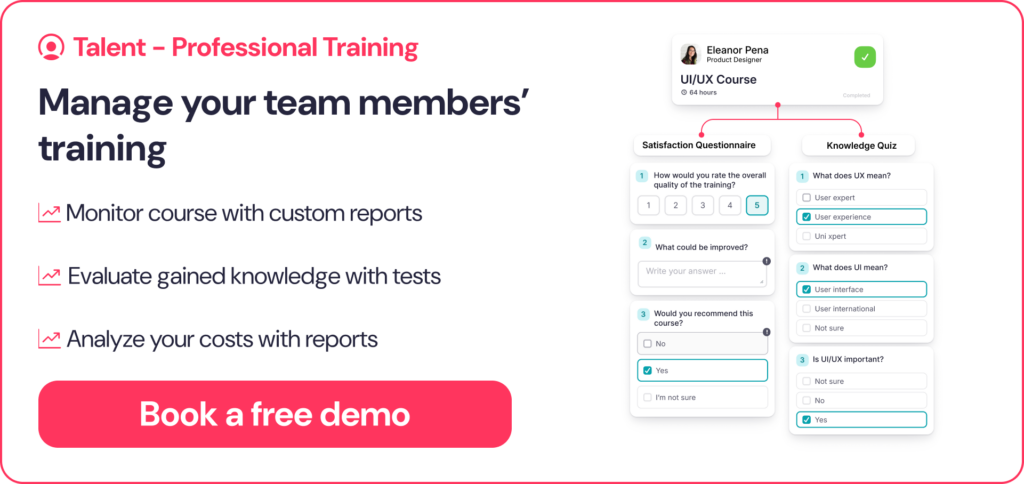Effective succession planning is a strategy for identifying and training potential leaders to help them advance professionally. When there is a good succession plan in place, it means there will always be a trained employee who can take over a position when an employee leaves or changes their role.
In the article, we will explain what succession planning is, the benefits it brings to companies and a step-by-step guide to help you build an effective succession plan within your company.
What is Succession Planning?
Why is Succession Planning Important for Companies?
Now that we’ve discussed the succession planning meaning, let’s understand why it is crucial for companies. Succession planning plays a vital role in the talent management process. It helps companies to identify key roles in the organisation. In turn, enabling them to recognise employees with the right skills for any positions that need to be filled.
Additionally, creating a succession plan helps mitigate any risk when key members leave the company, retire, or have to take an extended leave. This offers stability and ensures the company is not negatively impacted due to internal conflict. Further benefits for companies are:
- Knowledge transfer: A solid succession plan ensures that when a key employee leaves, their knowledge remains within the organization. This prevents the loss of valuable insights and expertise.
- Action plans for hypothetical situations: You can be confident that your company will be prepared for any situation. With a plan in place, your company can navigate unexpected changes or transitions without disrupting daily business operations.
- Employee Development: Succession planning creates opportunities for learning and development programmes. These L&D programmes help employees build new skills, improve job satisfaction, and reduce turnover.
Benefits of Succession Planning for Organisations
Succession planning is a great strategy for any company. Companies need to be ready for when employees leave or change positions, whether it’s planned such as a promotion or retirement, or an unexpected resignation.
Here are some of the key benefits of succession planning for companies:
- Increased employee engagement: A succession plan demonstrates how much you value your employees. Recognising and rewarding high performers gives employees a clear goal to work towards beyond the business objective.
- Cost-effective: A succession plan sources internal candidates so that companies can spend less on hiring, onboarding and training.
- Stronger internal hires: Employees are more motivated knowing that their hard work is recognised which leads to a greater quality of work and performance. Internal hires are less of a risk.
- Reduced hiring time: Some positions can take a while to fill, and this can cause a huge delay in terms of project management and production.
- Maintain company growth plan: By training your existing employees, you can support your growth plan by already having the necessary employees ready to step into any new roles.
- Promoting career development: In this competitive job market, candidates are searching for companies with clear career development plans in place.
- Company reputation: With a strong succession plan in place, you prove to potential candidates and clients your willingness to invest in your employees, improving your company reputation and culture.
- Positively affects business: By empowering your employees and enabling them to grow professionally, you make your organisation more competitive, keeping on top of industry trends and developing sought-after skills.
A step-by-step guide to Succession Planning
In order to be efficient, you need to have a succession plan in place. We’ve broken succession planning down into three key stages with clear step-by-step instructions to help you build an effective succession plan for your employees.
Here are some of the general steps you’ll need to take:
First Stage: The Assessment Phase
Step 1: Identify any business challenges in the upcoming years
Start by mapping out who your company is and any potential challenges you may face in the coming years to plan properly for its future
Step 2: Identify the key positions and qualifications that influence success in your company
Step 3: Assess the risk of those positions becoming unfilled
Second Stage: The Evaluation phase
Step 4: Consider potential employees for these roles
Step 5: Select the competencies individuals will need to be successful in positions and to meet identified business challenges
Final Stage: Development phase
Step 6: Encourage knowledge sharing and development before skilled individuals leave the company
Step 7: Develop a talent pool ready to step into critical positions through targeted career development strategies
Best Practices on How to Write a Succession Plan
Writing your company’s succession plan may seem difficult at first. However, after outlining the 3 main stages of creating a succession plan, you only need to following these best practices to proceed. Let’s take into our earlier outline in consideration to proceed.
- After assessing which key positions are needed for the success of your business, rank them in order of importance. That way you’ll be able to prioritize the skills that are needed for these positions. Moreover, you’ll be able to identify if any member of your current team could potentially fill the role.
- Utilise learning platforms, mentor programmes, or specific workshops to develop your team’s skills.
- Use a succession planning template to avoid starting from scratch. Additionally, make sure this plan is readily accessible and your team is clear on the steps needed to carry out this succession plan if necessary.
- Ensure you or your HR team reviews the company succession plan and update it when needed.
Essential Succession Planning Questions
A good succession plan is essential to the future success of your organisation. A key part of this is through knowing the right questions to ask. Here are some questions to consider when creating a succession plan for your organisation:
- What are the employee’s career goals? Are they realistic?
- Are their goals compatible with the organisational goals and needs?
- What actions has the employee completed so far? How successful were they?
- In what areas do you think the employee needs to develop new or more specific skills?
- Which resources, training, or experiences can you provide to help them reach their goal? Is there additional knowledge, certification, or education the employee needs to acquire?
Succession Planning With Factorial
Make your Succession Planning process easier with the help of Factorial – your business management software. With employee performance review tools, training management systems, and talent acquisition, Factorial makes this overall process simpler and more efficient.
Factorial automates your business management, making it easier to focus on developing your company’s succession plan. It’s important to identify what skills are needed to replace a key position. By utilising a business software, these key steps are simplified:
- Monitoring your team’s performance to evaluate who is ready for more responsibility and can handle a leadership position.
- Tracking your team’s training progress to gain more insights into your teams skills and what is missing.
- Matching with candidates quicker in case you need to find an external candidate for extra support.
Related video: What is a Performance Improvement Plan? In this video, we discuss how to give your workers a roadmap to increased success.



